Abstract
Over the last decade, bisphenol A (BPA) has become a chemical of concern in the marine environment. There is little data on BPA levels in the eastern Adriatic Sea, Croatian waters. This study provides concentrations of BPA in marine sediments and suspended matter sampled from the Kaštela Bay (the central part of the Adriatic Sea) for two years. The results obtained show that BPA in sediment samples ranged from 1.05 to 46.31 µg kg−1, while they were higher in the suspended matter, ranging from 1.84 to 81.39 µg kg−1. To demonstrate a possible correlation between BPA concentrations and other parameters in sediment and suspended matter, the granulometric composition and organic matter content were determined. There was no correlation between BPA and investigated sediment characteristics. To assess the possible effects of BPA on marine biota, its possible estrogenic effect was also investigated by calculating estradiol equivalent concentration (EEQ, µg kg−1), the maximum value of which, in this study, was 0.0181 µg kg−1 in the sediment samples and 0.0317 µg kg−1 in suspended matter samples. Based on the presented results, it is unlikely that BPA could cause significant endocrine disruption to marine life in the study area.
1. Introduction
Bisphenol A (BPA) is an organic compound consisting of two phenol molecules linked by a methyl bridge and two methyl groups; IUPAC: 2,2-bis(4-hydroxyphenyl) propane. It belongs to the group of chemicals of anthropogenic origin that are continuously released into the environment. BPA is one of the endocrine-disrupting compounds (EDCs), defined as chemicals that affect the endocrine system and cause adverse effects in humans and animals by either binding to or blocking hormone receptors [1,2,3].
BPA is a high-volume production chemical [4] and one of the most widely produced EDCs, accounting for over 5.5 million tons per year [5]. It is used as a material in polycarbonate plastic and epoxy resin linings for food and beverage cans [6].
The leaching of BPA from materials can occur [7], leading to its release into the environment, which is considered to be the source of contamination [8]. Due to its constant release and leakage from the plastic products, this hazardous molecule has “pseudo-persistent” characteristics in spite of being biodegradable in the environment [3,6]. In the Kaštela Bay, BPA release is suspected to originate from the breakdown of plastics in the environment and the wastewaters. Studies have shown that BPA can be detected in marine surface waters, sediments and suspended matter [9,10,11]. BPA is a compound of moderate hydrophobicity [12], and it is therefore expected to have a modest capacity for bioaccumulation [3]. It is estimated that BPA in the environment is mostly presented in water and suspended solids (52%), soil (25%) and sediments (23%) [6,13].
The accumulation of plastic waste in the marine environment is worrying as studies have shown that BPA from plastic leaks faster [7,14], while its bacterial degradation is much slower [15] in marine than in freshwater systems.
Because of its toxicity, BPA is included in the list of candidates for priority substances under the Water Framework Directive Annex X (WFD, 2000/60/EC) [16] and the Environmental Quality Standards Directive Annex III (EQSD, 2008/105/EC) [17] as a substance under the review for possible identification as “priority substance” or “priority hazardous substance”. Accordingly, further studies focusing on the presence and behaviour of BPA and other EDCs in the marine environment are necessary, and these should also be monitored, as are other compounds in descriptors 8 and 9 of the Marine Strategy Framework Directive (MSFD, 2008/56/EC) [18]. Based on a limited set of data, the European Commission [19] set a theoretically Predicted No Effect Concentration in sediments (PNECsed; the maximum concentration at which no adverse effects of BPA on organisms are observed) as 63 μg kg−1 (dw).
Information on BPA levels in the marine environment of the Croatian part of the Adriatic Sea is scarce [20], and there is also very little information about BPA in the suspended matter in the literature, especially in correlation to those in the sediment. This paper presents the results of BPA concentrations and the assessment of the potential estrogenic effect of BPA in sediments and suspended matter collected in Kaštela Bay.
2. Materials and Methods
2.1. Study Area
Kaštela Bay is a semi-enclosed bay located in the central part of the eastern Adriatic Sea, on the Croatian coast. The bay covers an area of 61 km2 with an average depth of 23 m. Because of agricultural areas extending along its northern coast and the municipal and industrial effluents that they go into, the bay is under strong anthropogenic influence. The bay has a relatively wide (1.8 km) and deep mouth (average depth about 40 m) through which it communicates with the adjacent sea. The most crucial influx of freshwater to this bay is the river Jadro. Local winds, Sirocco (SE wind), Bora (NE wind) and Mistral (NW wind) are responsible for general water circulation.
Up until thirty years ago, Kaštela Bay coast was an industrial zone with several factories among which two produced plastic compounds and up until 2004 wastewaters were discharged directly into the bay. Nowadays, it is a highly urbanised and agricultural area with three towns surrounding it. A cement plant, shipyard, two leisure boat marinas and a cargo port are located on its coastline, which consequently has intensive ship traffic.
Three sampling stations were selected for the purpose of this study, and their locations are shown on the map in Figure 1. Stations S1 and S2 are located in front of a heavily urbanised agricultural and industrial area, while station S3 is located at the entrance to the bay, further away from the urbanised area.
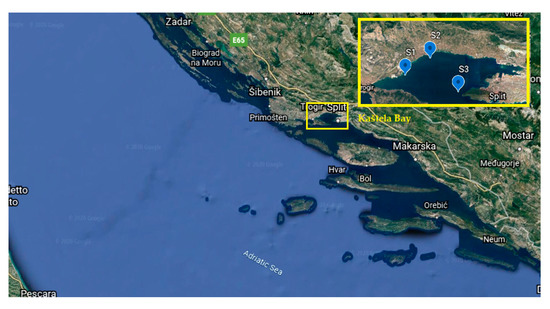
Figure 1.
Map of sampling stations (S1–S3) in the Kaštela Bay (Adriatic Sea, Croatia). Longitude and latitude of the sampling stations S1 (16°18′21″: 43°31′40″), S2 (16°21′12″: 43°33′01″), S3 (16°18′21″: 43°31′40″).
2.2. Sampling of Sediments and Suspended Matter
Surface sediment layer samples (0–4 cm) from the three sampling stations (depth 10 m) in the Kaštela Bay were sampled by SCUBA-divers with BPA-free plastic cylinders from April 2015 through to March 2017. During the first year, sampling was conducted once a month and during the second year every two months.
Suspended matter samples were collected during the same investigating period using the sediment traps (Figure 2) constructed of BPA-free plastic tubes, 50 cm in height and 10 cm in diameter placed at three different depths of the water column (sediment trap depths: 4, 8, 10 m) on all three stations.
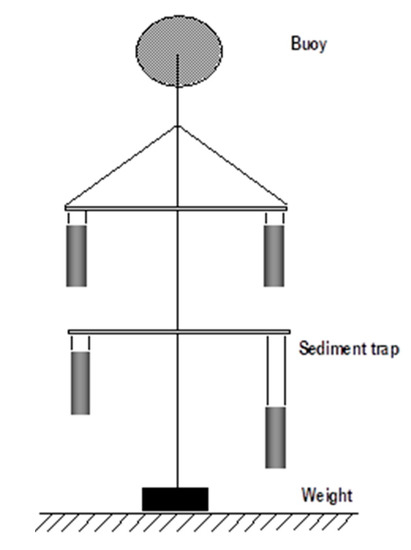
Figure 2.
Sediment traps in the water column on the construction, which was built for the purpose of research.
Samples were immediately frozen and lyophilised until further analysis. There was no sampling in December 2015 and 2016 due to the weather conditions and SCUBA-diver unavailability. In cases when it was estimated that there was not enough suspended matter in the sediment traps sample was not collected.
2.3. Sample Preparation, Determination of Granulometric and Organic Matter Content
Granulometric content was determined in non-homogenized sediment by sieving (>63 μm) and the hydro-metric method (<63 μm) [21]. Sediment type was determined according to Folk classification [22].
Sample analysis required homogenisation, and the gravimetrical method was used for organic matter determination (OM). Samples of sediments and suspended matter were treated with H2O2 and then heated at 450 °C for 360 min. The loss of weight of the samples as the result of this treatment was assumed to be due to OM content.
2.4. Extraction of BPA in Sediment and Suspended Matter
The adapted method of Pojana et al. [9] was used to extract BPA from sediments and suspended matter. From each homogenised sample, 5.00 ± 0.10 g aliquot was weighted into 50 mL polypropylene centrifuge tube. Aliquots were extracted in 5 mL solution mixture (1:9, v/v) of dichloromethane (DCM) and methanol (MeOH). Sonification (60 min at 25 °C) and shaking (180 min at 25 °C in a rotary shaker) were used to enhance the extraction. Samples were centrifuged for 40 min at 2921 RCF (Hettich Rotina 380, Germany) and the supernatant was filtered through a 0.45 μm polytetrafluoroethylene filter (PTFE). It was necessary to pool suspended matter samples collected at three water column depths as individual subsamples weights were insufficient for the extraction.
2.5. HPLC Analysis
Sediment and suspended matter extracts were analysed using high-performance liquid chromatography with fluorescence detection (HPLC-FLD) employing Varian ProStar 230 analytical system coupled with a 410 autosampler, a ProStar 500 column valve module and a 363 fluorescence detector with the excitation wavelength set to 227 nm and emission to 313 nm. Reversed phase C18 column (Restek, Pinnacle II 5 μm, 250 × 4.6 mm) protected by a guard cartridge (Pinnacle II C18, 20 × 4.0 mm) was utilised for the separation of BPA. Run time was 12 min, partial loop fill volume set to 10 µL and column temperature kept at 30 °C. Varian Star Chromatography software was used for data collection and processing. Obtained chromatograms of BPA in sediment and suspended matter samples were compared with those of standard solutions, identified by its retention time and quantified. To show linearity, a five-point calibration curve in the range of 1–5 µM was obtained (r = 0.99). For each batch of samples, procedural blank, check standard, matrix spike and duplicate analysis were established.
2.6. Data Analysis
In this research, statistical methods (e.g., average value, standard deviation, maximum and minimum concentration values) were used in data analysis and the concentration distribution diagrams were sketched with Microsoft Excel 2016. The correlation between the sediment characteristics (e.g., grain size, OM) and BPA concentration was analysed by calculating the Pearson correlation coefficient with Microsoft Excel 2016.
2.7. Estradiol Equivalent Concentration
To evaluate the potential estrogenic effect of BPA in the marine environment of the Kaštela Bay, the concentration of BPA was converted to the estradiol equivalent concentration (EEQ, µg kg−1), as this is the way to represent the ability of some chemical compound to cause estrogenic effects, compared to the estrogenic effects naturally induced by estradiol (E2). To calculate the EEQ, the following formula was used:
EEQBPA = CBPA·EEFBPA
In the presented equation, “C” represents BPA concentration in the sample and EEF is the estradiol equivalency factor relative to estradiol. According to the different methodology for EEF estimation, different values for it can be found in the literature. In the present study, EEF from Vega-Morales et al. [23] was applied where authors used the average of several BPA EEFs found in the literature.
3. Results
3.1. Granulometric Composition and Organic Matter Content
As shown in Figure 3, taking into account all sediment samples collected in the Kaštela Bay, the predominant grain size fraction was sand with an average content of 76.13 ± 6.01%.

Figure 3.
Granulometric composition of the sediment collected at stations S1 to S3 in the Kaštela Bay (Adriatic Sea, Croatia).
Other sediment components were gravel and mud with an average content of 12.50 ± 5.92% and 11.37 ± 0.91%, respectively. The highest percentage of gravel was determined at station S3, which is located at the entrance of the bay. The sediments of all three stations are characterised by a high percentage of coarse-grained particles and were classified as gravelly muddy sands, according to Folk [22].
The content of organic matter (OM) in all sediment samples shown in Figure 4 ranged from 1.40% (S1, October) to 3.22% (S3, April). Looking at the averages of the individual stations, they ranged from 2.13 ± 0.46% (S1) to 2.65 ± 0.41% (S3), as shown in Figure 5, and the average content for all three stations was 2.35 ± 0.47%.
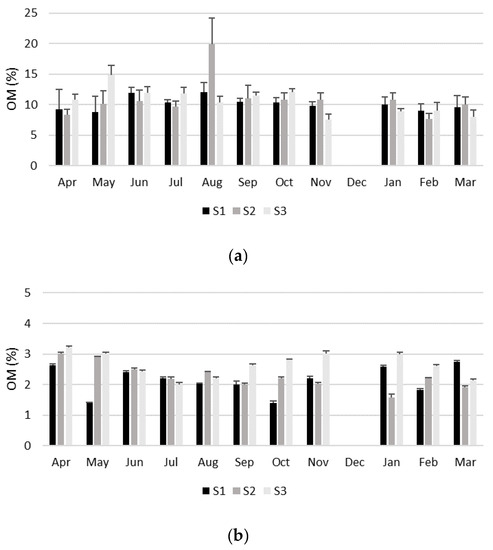
Figure 4.
Organic matter content (OM) in: (a) suspended matter and (b) sediment samples collected at stations S1 to S3 in the Kaštela Bay (Adriatic Sea, Croatia) from April 2015 to March 2016.
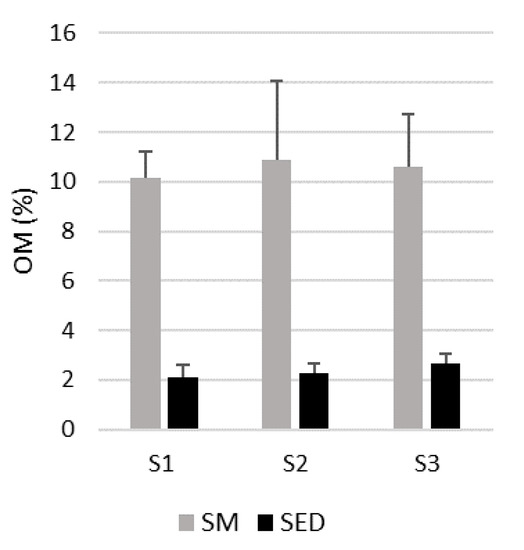
Figure 5.
Average OM concentrations in suspended matter (SM) and sediment samples (SED) collected at stations S1 to S3 in Kaštela Bay (Adriatic Sea, Croatia) from April 2015 to March 2016.
The OM content of suspended matter ranged from 7.54% (S3, November) to 19.89% (S2, August), as shown in Figure 4, with an average content of 10.55 ± 2.24% for all stations. The average OM value for each station (Figure 5) ranged from 10.15 ± 1.07% (S1) to 10.90 ± 3.17% (S2).
The monthly distribution of OM content in sediment and suspended matter (Figure 4) showed lower values during the cold season (the average in the months October to March was 2.28 ± 0.50% and 9.63 ± 1.28%, respectively) and higher values during the warm season (the average in the months April to September was 2.40 ± 0.45% and 11.32 ± 2.60%, respectively). The seasonal difference was more pronounced for suspended matter than for sediments.
3.2. BPA
BPA was detected in all sediment samples of the present study, with concentrations ranging from 1.05 µg kg−1 at S1 in January 2017 to 46.31 µg kg−1 at S2 in March 2016 (Figure 6) with an average value 4.37 ± 6.47 µg kg−1 for all stations. In suspended matter, BPA concentration ranged from 1.84 µg kg−1 at S1 in September 2016 to 81.39 µg kg−1 at S1 in January 2017 (Figure 6), with an average 14.77 ± 18.39 µg kg−1, which is approximately three times higher than the value determined for the sediment samples.
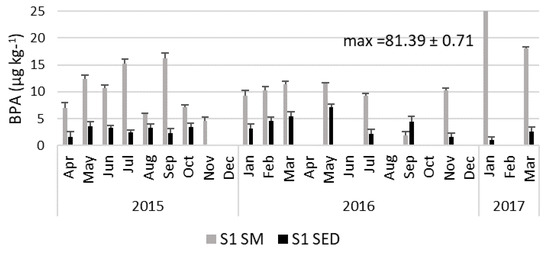
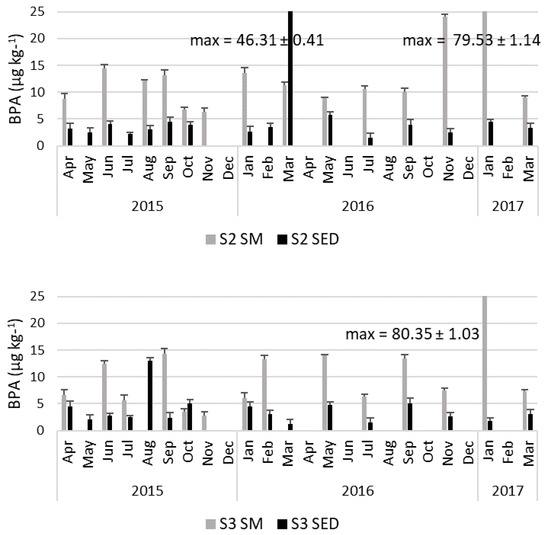
Figure 6.
Bisphenol A (BPA) concentrations in the suspended matter (SM) and sediment samples (SED) collected over two years (April 2015 to March 2017) at stations S1 to S3 in the Kaštela Bay (Adriatic Sea, Croatia).
Maximum sediment BPA concentrations were observed at station S2 with an average of 6.09 ± 10.78 µg kg−1 (Figure 7), which is about 60% higher than at the other two sampling stations. The average values for stations S1 and S3 were 3.28 ± 1.58 µg kg−1 and 3.75 ± 2.78 µg kg−1, respectively. Similar to the sediment sampling results, the highest BPA values in the suspended matter were found at station S2 (average 16.33 ± 18.70 µg kg−1). It should be noted that this was also the highest average value recorded for all samples (both sediment and suspended matter) from all stations investigated.
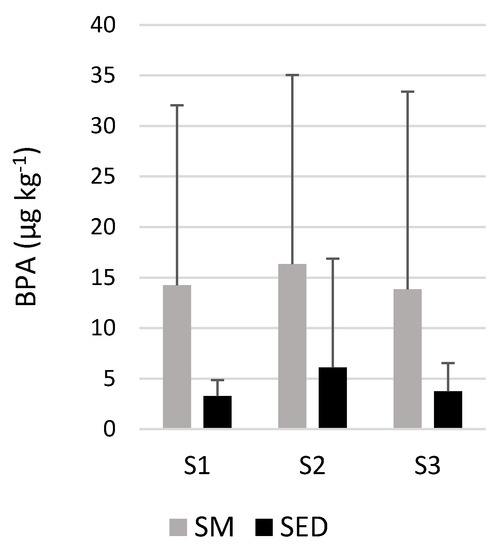
Figure 7.
Average BPA concentrations in the suspended matter (SM) and sediment samples (SED) collected at stations S1 to S3 in the Kaštela Bay (Adriatic Sea, Croatia) over two years (April 2015 to March 2017).
3.3. Temporal and Seasonal Distribution of BPA
The average BPA concentration in the Kaštela Bay during the first year of sampling (April 2015 to March 2016) was 9.68 ± 3.84 and 5.16 ± 8.17 µg kg−1 in suspended matter and sediment samples, respectively. In the following year of sampling (April 2016 through March 2017), the average concentrations were 23.30 ± 27.67 and 3.30 ± 1.74 µg kg−1 in samples of suspended matter and sediment, respectively.
The average annual BPA concentrations were calculated for all stations individually; the results are shown in Figure 8. The sediment samples showed that the yearly average was in the range of 3.14 ± 1.45 µg kg−1 for S3 (April 2016 to March 2017) to 7.61 ± 13.62 µg kg−1 for S2 (April 2015 to March 2016) and the suspended matter content was in the range of 8.09 ± 4.55 µg kg−1 for S3 (April 2015 to March 2016) to 23.70 ± 27.96 µg kg−1 for S2 (April 2016 to March 2017). The highest BPA levels were measured at station S2 in both sediment and suspended matter samples, which may indicate higher BPA contamination in this area.
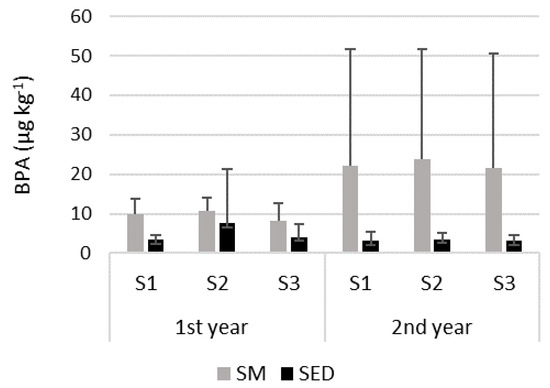
Figure 8.
Annual average of the BPA concentrations for suspended matter (SM) and sediment samples (SED) collected at stations S1 to S3 in the Kaštela Bay (Adriatic Sea, Croatia) over two years (April 2015 to March 2017).
The monthly and annual variations in BPA concentrations in the sediment and suspended matter samples collected at the investigated stations are shown in Figure 6 and Figure 8. It can be seen that in only two samples higher BPA concentrations were observed in sediment than in suspended matter.
Given the relatively high variability of BPA concentrations during the study mentioned above period, no seasonal changes in the monthly distribution of BPA in sediment and suspended matter were observed. To confirm this statement, a linear regression analysis of BPA concentrations during the cold (October to March) and warm season (April to September) was performed. The analysis presented in Figure 9 showed no trend of an increase or decrease in BPA concentration values during the seasons. The absence of statistically significant correlations within the seasons did not imply a trend of an increase or decrease in BPA concentrations.
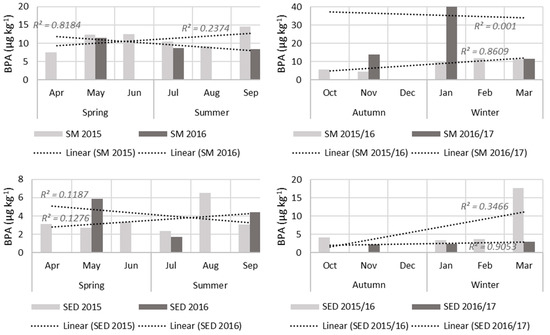
Figure 9.
Average monthly BPA concentrations for suspended matter (SM) and sediment samples (SED) collected at stations S1 to S3 in the Kaštela Bay (Adriatic Sea, Croatia ) over two years (April 2015 to March 2017), represented by the cold (October to March) and warm (April to September) seasons.
3.4. The Estrogenic Potential of BPA
The EEQ was calculated for each suspended matter and sediment sample (Table 1). While the suspended matter samples had an EEQ in the range of 0.0007–0.0317 µg kg−1, the sediment samples that resulted in lower EEQs had the lower BPA values and the range 0.0004–0.0181 µg kg−1.

Table 1.
Calculated estradiol equivalent concentrations (EEQs) for suspended matter (SM) and sediment samples (SED) collected during two years (April 2015 to March 2017, samples taken in triplicates) at stations S1 to S3 in the Kaštela Bay (Adriatic Sea Croatia).
4. Discussion
The results for OM in sediments and suspended matter are consistent with those previously determined by Matijević et al. [21] for the central Adriatic Sea sediments (samples range from 0.55–8.72% and the average OM content is 3.84 ± 2.40%). The organic matter content of all collected sediment samples corresponded to the granulometric composition, which has already been documented for the nearshore stations along the east Adriatic Sea coast [24,25]. As expected, OM content in the suspended matter was higher than in the sediment because the fine-grained particles in the suspended matter are the dominant fraction [26]. Concerning the location of the stations in the bay, no difference in OM content was observed. The monthly distribution of the sediment and suspended matter OM contents presented in the study by Anđelić et al. [20] showed a seasonal distribution of OM in the sediment from the Kaštela Bay, which is in contradiction to the present study. This could be explained by the different wastewater discharges and anthropogenic pressures that make the inflow of organic particles seasonally independent.
In general, BPA has been found in the suspended matter at higher levels than in sediment samples, which can be attributed to a higher organic content in suspended matter due to the affinity of BPA for small organic particles [27]. In the present study, no correlation was found between OM content and BPA concentrations in sediment or suspended matter (R2 ≤ 0.05 and R2 ≤ 0.03 for sediment and suspended matter, respectively), which is in line with the results of Peng et al. [28]. The explanation for the lack of this correlation may be the diffuse influx of BPA into the bay. Its low octanol–water partition coefficient (Kow) and the fact that it is readily biodegradable under aerobic conditions in soil and sediments should also be taken into account [29]. For these reasons, it is expected to be the least persistent in the environment.
The results obtained in this study for BPA concentrations in the environment are lower than those obtained by Pojana et al. [9] for BPA concentrations found in sediments sampled in the north of Adriatic Sea (Venice Lagoon, Italy), ranging from 2.1 to 118 µg kg−1, with an average of 44.89 ± 43.60 µg kg−1 and those reported for the lagoons in Po River delta with the average of 18.64 ± 9.30 µg kg−1 [30]. Zoppini et al. [31] published the values of measured BPA concentrations in marine sediments sampled along the west Adriatic Sea coast and at two deep-sea sampling sites, Jabuka and Southern Adriatic Pits. The highest BPA concentrations were measured in the Po river delta (38.3 µg kg−1) and the lowest off the port of Bari (0.4 µg kg−1). The average BPA concentration at deep sites (4.0 ± 1.9 µg kg−1) was about twice as high as that measured on the south-west Adriatic Sea coast (1.8 ± 1.3 µg kg−1). Comparing these results with those obtained in the present study, the highest BPA concentration value observed in the sediment samples of the present study (46.31 µg kg−1) was found to be consistent with that found for the Po river delta. In comparison, the average value of the present study (4.37 ± 6.47 µg kg−1) is consistent with the results of Zoppini et al. [31] for the deep sea sites, although it is twice as high as the average value measured for the south-west Adriatic Sea coast (1.8 ± 1.3 µg kg−1). Recently, Staniszewska et al. [32] reported BPA concentrations in sediment samples collected in the coastal zone of the Gulf of Gdansk (Southern Baltic Sea) ranging from 0.08 to 26.39 µg kg-1, which is within the range of BPA concentrations in sediment samples presented in this paper. In their preliminary investigation in the Kaštela Bay, Anđelić et al. [20] found that BPA concentrations were in the range of 5.32–15.52 µg kg−1, with average values of 11.82 ± 2.82 µg kg−1, which are higher than those found in the present study. If the results of the present study are compared with those of Zoppini et al. [30] and Pojana et al. [9], it can be seen that the Kaštela Bay is less polluted than the central and northern Italian coast of the Adriatic Sea.
The BPA concentrations in suspended matter obtained by this study were in the range 1.84–81.39 µg kg−1 and the average was 14.77 ± 18.23 µg kg−1. The values presented here were lower than those reported by Anđelić et al. [20] in the study conducted in the Kaštela Bay (range 4.66–103.06 µg kg−1) and lower than those reported by Arditsoglou and Voutsa [10] for Thermaikos Bay Greece, which showed the range 26–160 µg kg−1. It should be noted that literature data on BPA concentrations in the marine suspended matter are scarce and insufficient for comparison. However, taking into account a freshwater suspended matter, BPA concentrations in this study were higher than those reported for freshwater in the Netherlands (5.56–56 µg kg−1) [33] and lower than those reported for the Tiber (360–660 µg kg−1) in Italy [34].
In January 2017, high BPA concentrations in the suspended matter were measured at all three stations (79.53 µg kg−1 at station S2 to 81.39 µg kg−1 at station S1), while the same results were not obtained in sediment samples.
It was found that there are no seasonal patterns in the behaviour of BPA, which is due to the anthropogenic origin of BPA. According to Ying and Kookana [29] and Hermabessiere et al. [35], BPA concentrations depend mainly on the inflow into the bay, the degradation of polycarbonates in situ and the rate of degradation of BPA in the water column.
In all sediment samples, the BPA concentrations were below the PNECsed of 63 µg kg−1 (dw). There is no official theoretically Predicted No Effect Concentration for suspended matter, so BPA concentrations in the suspended matter were compared to those in sediment and it was found that, in some samples, the BPA concentration was above the PNECsed. However, since the present study showed a pronounced short-term variability in BPA concentrations, probably due to the irregular inflow of BPA into the bay, and its biodegradation, occasional high BPA concentrations in suspended matter samples in the Kaštela Bay should not be a cause for concern.
The EEQs obtained in this study are very low compared to other studies, as their maximum was 0.0317 µg kg−1 (dw). Vega-Morales et al. [23] found that the EEQs for sludge samples from wastewater treatment plants ranged from 8.6 to 238.8 µg kg−1. Pignotti and Dinelli [36] estimated the EEQs for river sediment samples to range from 0.0005 to 0.48 µg kg−1. Based on the results obtained for the study area, it is therefore unlikely that BPA exerts strong endocrine disruption on aquatic or benthic organisms. It should be kept in mind that other EDCs were not included in the overall estrogenic assessment, and further studies are needed to obtain a more realistic estimate of the EEQ of sediment and suspended matter.
5. Conclusions
BPA concentrations in marine sediments and suspended matter from the central Adriatic Sea (Kaštela Bay) were determined during the two-year study period. Concentration values in sediment samples ranged from 1.05 to 46.31 µg kg−1, while they were higher in the suspended matter, ranging from 1.84 to 81.39 µg kg−1.
The OM content in the suspended matter was determined in the range of 7.54% to 19.89%, which is higher than in the sediment samples (1.40–3.22%). The suspended matter has a fine-grained structure and therefore forms relatively intensive bonds with organic compounds such as BPA, which contributed higher BPA concentrations in suspended matter samples.
The present study shows an increased short-term variability of BPA concentration levels in sediment and suspended matter samples, due to the irregular inflow of BPA into the bay, the low Kow value and its ready biodegradability. All sediment BPA concentrations were lower than PNECsed, and the calculated EEQ values for sediment and suspended matter were lower than in the published studies consulted. Based on these results, it is therefore unlikely that BPA could cause significant endocrine disruption to marine life in the study area due to its high variability and the only occasionally high BPA concentrations in suspended matter samples. Therefore, there should be no cause for concern in the bay. However, even if there is no immediate risk of BPA inflicting harmful effects on marine life, its erratic behaviour and incidence would justify the monitoring of this compound.
Author Contributions
Conceptualisation, I.A. and S.M.; methodology, I.U. and R.R.-B.; validation, I.U. and R.R.-B.; formal analysis, I.A.; investigation, R.R.-B; resources, I.U.; data curation, I.A. and N.V.; writing—original draft preparation, I.A. and R.R.-B.; writing—review and editing, R.R.-B., I.U. and S.M.; visualisation, I.A.; supervision, S.M.; project administration, I.U. and R.R.-B.; funding acquisition, I.A. and N.V. All authors have read and agreed to the published version of the manuscript.
Funding
This study was supported by the Ministry of Science and Education of the Republic of Croatia as a part of Multiannual Financing intended for institutions.
Conflicts of Interest
The authors declare no conflict of interest.
References
- Witorsch, R.J. Endocrine Disruptors: Can Biological Effects and Environmental Risks Be Predicted? Regul. Toxicol. Pharmacol. 2002, 36, 118–130. [Google Scholar] [CrossRef] [PubMed]
- US Environmental Protection Agency. Bisphenol A Action Plan; US Environmental Protection Agency: Washington, DC, USA, 2010; pp. 1–22.
- Flint, S.; Markle, T.; Thompson, S.; Wallace, E. Bisphenol A exposure, effects, and policy: A wildlife perspective. J. Environ. Manag. 2012, 104, 19–34. [Google Scholar] [CrossRef] [PubMed]
- Wei, X.; Huang, Y.; Wong, M.H.; Giesy, J.P.; Wong, C.K.C. Assessment of risk to humans of bisphenol A in marine and freshwater fish from Pearl River Delta, China. Chemosphere 2011, 85, 122–128. [Google Scholar] [CrossRef] [PubMed]
- Bailin, P.S.; Byrne, M.; Sanford, L.; Richard, L.; Lewis, S.; Liroff, R. Public Awareness Drives Market for Safer Alternatives: Bisphenol A Market Analysis Report; IEHN: New York, NY, USA, 2008; pp. 1–37. [Google Scholar]
- Staples, C.; Dome, P.; Klecka, G.; Oblock, S.T.; Harris, L.R. A review of the environmental fate, effects, and exposures of bisphenol A. Chemosphere 1998, 36, 2149–2173. [Google Scholar] [CrossRef]
- Sajiki, J.; Yonekubo, J. Leaching of bisphenol A (BPA) from polycarbonate plastic to water containing amino acids and its degradation by radical oxygen species. Chemosphere 2004, 55, 861–867. [Google Scholar] [CrossRef]
- Vandermeersch, G.; Van Cauwenberghe, L.; Janssen, C.R.; Marques, A.; Granby, K.; Fait, G.; Kotterman, M.J.J.; Diogène, J.; Bekaert, K.; Robbens, J.; et al. A critical view on microplastic quantification in aquatic organisms. Environ. Res. 2015, 143, 46–55. [Google Scholar] [CrossRef]
- Pojana, G.; Gomiero, A.; Jonkers, N.; Marcomini, A. Natural and synthetic endocrine disrupting compounds (EDCs) in water, sediment and biota of a coastal lagoon. Environ. Int. 2007, 33, 929–936. [Google Scholar] [CrossRef]
- Arditsoglou, A.; Voutsa, D. Occurrence and partitioning of endocrine-disrupting compounds in the marine environment of Thermaikos Gulf, Northern Aegean Sea, Greece. Mar. Pollut. Bull. 2012, 64, 2443–2452. [Google Scholar] [CrossRef]
- Careghini, A.; Mastorgio, A.F.; Saponaro, S.; Sezenna, E. Bisphenol A, nonylphenols, benzophenones, and benzotriazoles in soils, groundwater, surface water, sediments, and food: A review. Environ. Sci. Pollut. Res. 2015, 22, 5711–5741. [Google Scholar] [CrossRef]
- Staniszewska, M.; Soko, A.; Nehring, I.; Wasik, A.; Jendzul, A. Factors determining accumulation of bisphenol A and alkylphenols at a low trophic level as exempli fi ed by mussels Mytilus trossulus. Environ. Pollut. 2017, 220, 1147–1159. [Google Scholar] [CrossRef]
- Cousins, I.; Staples, C.; Klecka, G.; Mackay, D. A multimedia assessment of the environmental fate of bisphenol A. Hum. Ecol. Risk Assess. 2002, 8, 1107–1135. [Google Scholar] [CrossRef]
- Crain, D.A.; Eriksen, M.; Iguchi, T.; Jobling, S.; Laufer, H.; LeBlanc, G.A.; Guillette, L.J. An ecological assessment of bisphenol-A: Evidence from comparative biology. Reprod. Toxicol. 2007, 24, 225–239. [Google Scholar] [CrossRef] [PubMed]
- Kang, J.H.; Kondo, F. Bisphenol A degradation in seawater is different from that in river water. Chemosphere 2005, 60, 1288–1292. [Google Scholar] [CrossRef] [PubMed]
- European Commission. European Commission Directive 2000/60/EC of the European Parliament and of the Council of 23 October 2000 establishing a framework for Community actions in the field of water policy. Off. J. Eur. Union 2000, 22, 1–73. [Google Scholar]
- European Commission. European Commission Directive 2008/105/EC of the European Parliament and of the Council of 16 December 2008 on environmental quality standards in the field of water policy. Off. J. Eur. Union 2008, 384, 84–97. [Google Scholar]
- European Commission. European Commission Directive 2008/56/EC of the European Parliament and of the Council of 17 June 2008 establishing a framework for community action in the field of marine environmental policy (Marine Strategy Framework Directive). Off. J. Eur. Union 2008, 164, 19–40. [Google Scholar]
- Aschberger, K.; Munn, S.; Olsson, H.; Institute for Health and Consumer Protection. Updated European Union Risk Assessment Report: 4,4’-Isopropylidenediphenol (Bisphenol-A): Environment Addendum of February 2008; Publications Office: Luxembourg, 2010; ISBN 978-92-79-17541-1. [Google Scholar]
- Anđelić, I.; Matijevic, S.; Ujević, I. Preliminary investigation of bisphenol A in sediments and suspended matter in Kaštela Bay (Adriatic Sea, Croatia). Acta Adriat. 2015, 53, 259–268. [Google Scholar]
- Matijević, S.; Bogner, D.; Morović, M.; Tičina, V.; Grbec, B. Characteristics of the sediment along the eastern Adriatic coast (Croatia). Fresenius Environ. Bull. 2008, 17, 1763–1772. [Google Scholar]
- Folk, R.L. The Distinction between Grain Size and Mineral Composition in Sedimentary-Rock Nomenclature. J. Geol. 1954, 62, 344–359. [Google Scholar] [CrossRef]
- Vega-Morales, T.; Sosa-Ferrera, Z.; Santana-Rodríguez, J.J. Evaluation of the presence of endocrine-disrupting compounds in dissolved and solid wastewater treatment plant samples of Gran Canaria Island (Spain). BioMed Res. Int. 2013, 2013, 790570. [Google Scholar] [CrossRef]
- Ujević, I.; Odžak, N.; Barić, A. Relationship between Mn, Cr, Pb and Cd concentrations, granulometric composition and organic matter content in the marine sediments from a contaminated coastal area. Fresenius Environ. Bull. 1998, 7, 183–189. [Google Scholar]
- Bogner, D.; Ujević, I.; Zvonarić, T.; Barić, A. Distribution of selected trace metals in coastal surface sediments from the middle and south Adriatic Sea. Fresenius Environ. Bull. 2004, 13, 1281–1287. [Google Scholar]
- Ujević, I.; Kljaković-Gašpić, Z.; Bogner, D. Influence of suspended matter on cadmium accumulation in sediment from Kaštela Bay, Adriatic Sea, Croatia. Acta Adriat 2010, 51, 79–88. [Google Scholar]
- Shi, J.; Liu, X.; Chen, Q.; Zhang, H. Spatial and seasonal distributions of estrogens and bisphenol A in the Yangtze River Estuary and the adjacent East China Sea. Chemosphere 2014, 111, 336–343. [Google Scholar] [CrossRef] [PubMed]
- Peng, X.; Wang, Z.; Mai, B.; Chen, F.; Chen, S.; Tan, J.; Yu, Y.; Tang, C.; Li, K.; Zhang, G.; et al. Temporal trends of nonylphenol and bisphenol A contamination in the Pearl River Estuary and the adjacent South China Sea recorded by dated sedimentary cores. Sci. Total Environ. 2007, 384, 393–400. [Google Scholar] [CrossRef]
- Ying, G.G.; Kookana, R.S. Degradation of five selected endocrine-disrupting chemicals in seawater and marine sediment. Environ. Sci. Technol. 2003, 37, 1256–1260. [Google Scholar] [CrossRef]
- Zoppini, A.; Bongiorni, L.; Ademollo, N.; Patrolecco, L.; Cibic, T.; Franzo, A.; Melita, M.; Bazzaro, M.; Amalfitano, S. Bacterial diversity and microbial functional responses to organic matter composition and persistent organic pollutants in deltaic lagoon sediments. Estuar. Coast. Shelf Sci. 2020, 233, 106508. [Google Scholar] [CrossRef]
- Zoppini, A.; Ademollo, N.; Patrolecco, L.; Langone, L.; Lungarini, S.; Dellisanti, W.; Amalfitano, S. Distribution patterns of organic pollutants and microbial processes in marine sediments across a gradient of anthropogenic impact. Environ. Pollut. 2018, 242, 1860–1870. [Google Scholar] [CrossRef]
- Staniszewska, M.; Nehring, I.; Falkowska, L.; Bodziach, K. Could biotransport be an important pathway in the transfer of phenol derivatives into the coastal zone and aquatic system of the Southern Baltic? Environ. Pollut. 2020, 262, 114358. [Google Scholar] [CrossRef]
- Vethaak, A.D.; Lahr, J.; Schrap, S.M.; Belfroid, A.C.; Rijs, G.B.J.; Gerritsen, A.; de Boer, J.; Bulder, A.S.; Grinwis, G.C.M.; Kuiper, R.V.; et al. An integrated assessment of estrogenic contamination and biological effects in the aquatic environment of The Netherlands. Chemosphere 2005, 59, 511–524. [Google Scholar] [CrossRef]
- Patrolecco, L.; Capri, S.; De Angelis, S.; Pagnotta, R.; Polesello, S.; Valsecchi, S. Partition of nonylphenol and related compounds among different aquatic compartments in Tiber river (central Italy). Water Air Soil Pollut. 2006, 172, 151–166. [Google Scholar] [CrossRef]
- Hermabessiere, L.; Dehaut, A.; Paul-Pont, I.; Lacroix, C.; Jezequel, R.; Soudant, P.; Duflos, G. Occurrence and effects of plastic additives on marine environments and organisms: A review. Chemosphere 2017, 182, 781–793. [Google Scholar] [CrossRef] [PubMed]
- Pignotti, E.; Dinelli, E. Distribution and partition of endocrine disrupting compounds in water and sediment: Case study of the Romagna area (North Italy). J. Geochem. Explor. 2018, 195, 66–77. [Google Scholar] [CrossRef]
© 2020 by the authors. Licensee MDPI, Basel, Switzerland. This article is an open access article distributed under the terms and conditions of the Creative Commons Attribution (CC BY) license (http://creativecommons.org/licenses/by/4.0/).